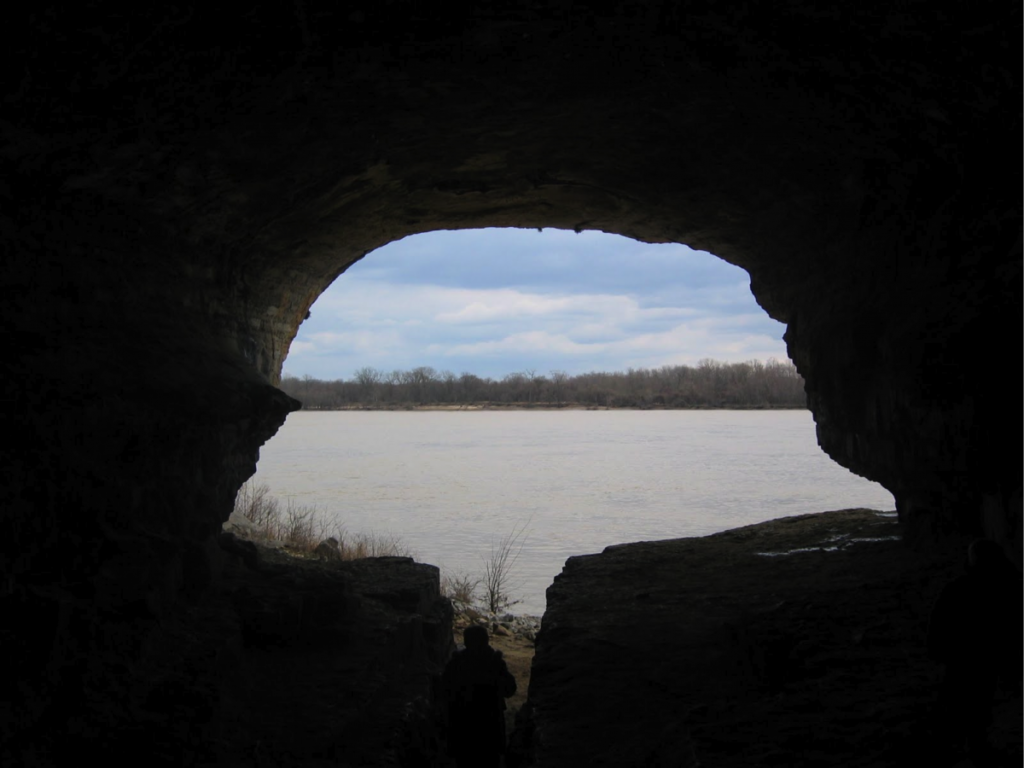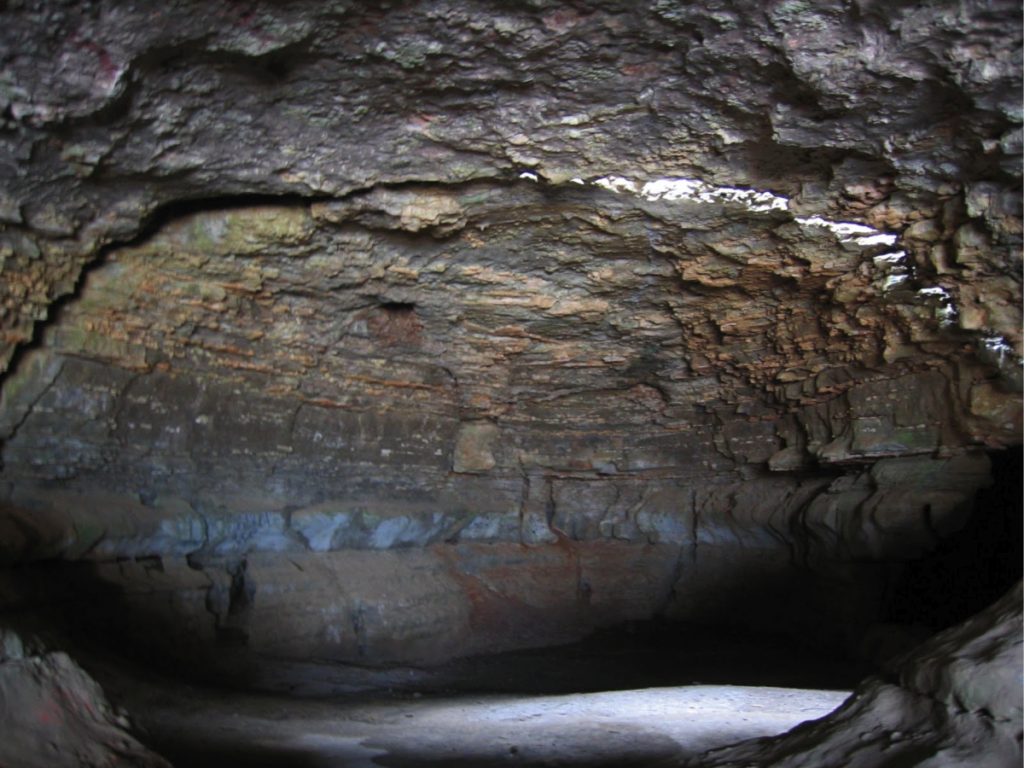
During the late 18th century and early 19th century, citizens of the newly formed United States were “seeking out the land’s scenic marvels, measuring their sublime effects in language, and even staging an informal competition for which site would claim pre-eminence as a scenic emblem of the young nation” (Sayre 141).
One particularly sees this take place in Thomas Jefferson’s descriptions of the Natural Bridge and the confluence of the Shenandoah and Potomac rivers in his Notes on the State of Virginia (1785). In this work, Jefferson observes and describes all manner of detail about his native state, from landscape, climate, agricultural and mineral resources, to the laws, manners, and religious beliefs of its citizens. It’s a celebration of all things Virginia in an attempt to show that state’s worth as a leader in the newly formed union.
Using the sublime in describing nature was a standard in travel and landscape writing during this period, namely because photography had not yet been invented and often landscape sketches and engravings were crude, falling far short of the grandeur of the scenes they were depicting (Sayre 144). Along with this, post-revolutionary America needed to create a national identity that put it on equal standing with the Old World. Without the usual markers of an aesthetic national tradition (the architectural ruins of past civilizations, like those of Rome or Greece, or of a long standing artistic tradition like that in Europe after the Renaissance) America had to rely on its natural landscape, and the descriptions of this landscape, to represent the ideals of the nation. (Sayre 144).
And Thomas Jefferson does exactly this when writing about the Natural Bridge in Virginia and the confluence of the Shenandoah and Potomac rivers in order to accomplish both of these things. As Lawson-Peebles points out, “the descriptions…are not outcrops of Romanticism in the stony soil of Enlightenment Rationalism, but rather carefully prepared and controlled landscape essays” (180-181).
With the Natural Bridge, Jefferson writes that it is “so beautiful an arch, so elevated, so light, and springing as it were up to heaven, the rapture of the spectator is really indescribable” (26). He marvels at its design, as if nature were the greatest of all architects to create such a thing of beauty, while at the same time constructing a very functional bridge spanning the Cedar Creek canyon at an opportune location (26-27).
And with the confluence of the rivers, he writes how the Shenandoah has “ranged along the foot of the mountain an hundred miles to seek a vent” and the Potomac “in quest of passage also…rush together against the mountain, rend it asunder, and pass off to the sea” (21). Not only is this sight “one of the most stupendous scenes in nature,” as Jefferson describes it, but it seems a perfect metaphor for the expansion of the new nation, seeking passage through the mountains to find the sea, though it is the western sea that, only a few years after this writing, Lewis and Clark will seek out at the orders of Jefferson.
But while looking at Jefferson’s descriptions of the Virginia landscape, his description of the Ohio River stood out to me. He begins with a note of the sublime, “The Ohio is the most beautiful river on earth. Its current gentle, waters clear, and bosom smooth and unbroken by rocks and rapids, a single instance only excepted” (12). But after this, he falls into a mechanical list of distance and depth measurements, indicating that he probably had not seen the river firsthand, but had relied on other travelers’ descriptions. Early French visitors called the Ohio “La Belle Riviere,” which seems to inform Jefferson’s first sentence in describing it (Rothert 18).
Looking further into Jefferson’s writing on the Ohio, I noticed a distance notation related to “The Big Cave,” which lies just above Ft. Massac. Having grown up near the Ohio River that makes up the southern border of Illinois, I immediately recognized this place as Cave-In-Rock. As the name suggests (a translation from the French “Caverne dans le Roc”), it is a giant cavern set into the rocky bluffs that make up the northern bank of the Ohio River. It measures 55 feet high at its mouth, 40 feet wide, and extends into the rock 165 feet (Rothert 18-19). Its location made it a favorite haunt of river pirates, of which there are many stories documented, but which won’t be recounted here. Instead, I found it interesting, and not surprising, that Jefferson would, of course, write great sublime prose about the natural wonders of his native state, but saw the distant reaches of the Ohio only as a practical means of transport to move goods to the Mississippi and beyond.

But just because Jefferson didn’t include the cave in his Notes On the State of Virginia doesn’t mean that others in the early American period left out a description as well. French travellers noted the cave as early as 1744. Victor Collot, a French Engineer, planned a stop at the “Big Cave” while writing his book A Journey in America in 1796, and in December of the same year, Andrew Ellicott, on his way to Natchez to survey the boundary between the U.S. and Spain, made an entry in his journal that said, “dined at the Great Cave…one of the greatest natural curiosities on the river” (Rothert 23).
The first detailed description of Cave-In-Rock comes from Thaddeus Harris’s The Journal of a Tour into the Territory Northwest of the Alleghany Mountains (1805). Here he states that the Indians called the Great Cave “the habitation of the Great Spirit” and then begins a description using sublime language, much the same as Jefferson did in his nature writing:
On the Indian side of the river you see large ponderous rocks piled one upon another, of different colors, shapes, and sizes. Some appear to have gone through the hands of the most skillful artist; some represent the ruins of ancient edifices; some thrown promiscuously in and out of the river, as if nature intended to shew us with what ease she could handle those mountains of solid rock. You see again purling streams winding their course down their rugged front; whose appearance in a moon-light night, added to the murmuring noise they occasion, is truly beautiful….After a small relief from this scene…you discover the cave. Before its mouth stands a delightful grove of cypress trees, arranged immediately on the bank of the river. They have a fine appearance, and add much to the cheerfulness of the place. (176-177)
The description goes on to give the dimensions of the cave, but one cannot help but see the same elements of sublime nature writing here that Jefferson used in his own work. There is the evocation of the divine, the fine artistry and immense power of nature, and the connection with the ancient world with its great edifices and cypress trees, making Cave-In-Rock an American version of The Temple of Zeus in Olympia.
A few years later, in 1807, another traveller, Fortesque Cuming, an Englishman, described the Cave in his Tour of the Western Country. He also employs the sublime style of the time:
Two thirds of a mile from hence, we thought we saw the Rocking cave, when we observed a cavern forty-five feet deep, three wide, and nine high, the floor ascending gradually to the vault at the end, where it is terminated by a petrifaction like the hanging pipes of a large organ. The sides, which meet at the top, forming a Gothick arch, are of limestone, with several large nuclei of flint, which seem to have been broken off designedly to smooth the inside of the cavern.
Rowing along shore with the skiff we were soon undeceived as to that’s being the Rocking cave, as a third of a mile lower down, one of the finest grottos or caverns I have seen, opened suddenly to view, resembling the choir of a large church as we looked directly into it. We landed immediately under it and entered it. It is natural, but is evidently improved by art in the cutting of an entrance three feet wide through the rock in the very centre, leaving a projection on each hand excavated above to the breadth of the cavern, the projections resembling galleries. The height of the mouth is about twenty-two, and that of the rock about thirty. It is crowned by large cedars, and black and white oaks, some of which impend over, and several beautiful shrubs and flowers, particularly very rich columbines, are thickly scattered all around the entrance. The length (or depth) of the cavern is fifty-five paces, and its breadth eleven or twelve.
Standing on the outside, the appearance of some of the company at the inner end of the cave was truly picturesque, they being diminished on the eye to half their size and removed to three times their real distance. (Thwaites 272-273)
Here again we see the elements of nature’s design and artistry, which created an architecture resembling the great cathedrals of Europe, relating America’s natural beauty to Old World aesthetics; and indescribable beauty is placed alongside practical description and measurement in exactly the same way Jefferson describes the natural wonders of Virginia.
What’s interesting is that in looking at more recent works, such as Beautiful Machine by John Seelye and Landscape and Written Expression in Revolutionary America by Robert Lawson-Peebles, two seminal books about nature and landscape writing in the early American period, neither one of these mentioned Cave-In-Rock in their discussions of writing about the Ohio River.
Not surprisingly, it seems that location and status played a role in determining what would be named as natural wonders in early America. Thomas Jefferson’s prose is no more literary than either Harris or Cuming, and the Natural Bridge and the confluence of the Shenandoah and Potomac, while both spectacular natural landscapes, are no more beautiful or remarkable than Cave-In-Rock. Yet, even now, it’s Jefferson’s descriptions that are studied, while Cave-In-Rock and the substantial literary output about it from the early American period are mostly forgotten. It seems a perfect invitation for a writer who grew up going to family reunions in the park that now surrounds the cave; a writer who has explored the inside of its caverns and grottoes many many times, and has climbed along the galleries and read the names carved into the walls from previous centuries, a few on the ceiling from when the river swelled above its banks; a writer whose mother and stepfather were married beneath a copse of trees on the bluff above the cave, overlooking the “most beautiful river on earth.” An invitation gladly accepted.
James Alan Gill has published fiction, non-fiction, and poetry in several journals including Colorado Review, Crab Orchard Review, Midwestern Gothic, The Common, and Atticus Review, and has work forthcoming in the anthology Being: What Makes A Man. He currently lives in Eugene, OR.
Works Cited
Harris, Thaddeus Mason. The Journal of a Tour Into the Territory Northwest of the Alleghany Mountains Made in the Spring of the Year 1803: With a Geographical and Historical Account of the State of Ohio. Boston: Manning & Loring, 1805. books.google.com. Web. 31 May 2014.
Jefferson, Thomas. Notes on the State of Virginia. Ed. Frank Shuffelton. New York: Penguin, 1999. Print.
Lawson-Peebles, Robert. Landscape and Written Expression in Revolutionary America: The World Turned Upside down. Cambridge: Cambridge UP, 1988. Print.
Rothert, Otto A. The Outlaws of Cave-in-Rock: Historical Accounts of the Famous Highwaymen and River Pirates Who Operated In Pioneer Days Upon the Ohio and Mississippi Rivers and Over the Old Natchez Trace. Carbondale: Southern Illinois UP, 1996. Print.
Sayre, Gordon M. “If Thomas Jefferson Had Visited Niagara Falls: The Sublime Wilderness Spectacle in America, 1775-1825.” Isle 8.2 (2001): 141-62. Print.
Thwaites, Reuben Gold, ed. Early Western Travels, 1748-1846: A Series of Annotated Reprints of Some of the Best and Rarest Contemporary Volumes of Travel: Descriptive of the Aborigines and Social and Economic Conditions in the Middle and Far West, during the Period of Early American Settlement. Cleveland, OH: A.H. Clark, 1904. books.google.com. Web. 31 May 2014.



